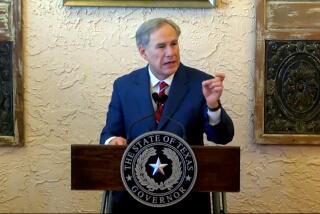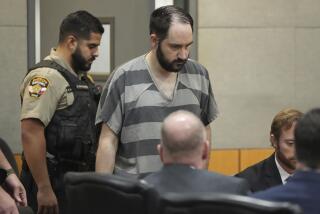Texas Jury Finds Third Man Guilty in Dragging Death
HOUSTON — Jurors Thursday found a third white man guilty of capital murder but spared him the death penalty in a shocking 1998 killing that occurred on an East Texas road and became a looking glass into the state of race relations in America.
Deliberating over two days, the jury in Jasper took far longer than had similar panels that tried Shawn Allen Berry’s cohorts in the crime. Berry, 24, had no comment as he embraced his girlfriend when the verdict was returned.
After a brief penalty hearing, the all-white jury quickly agreed on a sentence of life in prison. Berry must serve at least 40 years before he has a chance of parole.
In separate trials earlier this year, Lawrence Russell Brewer, 32, and John William King, 25, were sentenced to death for kidnapping James Byrd Jr., 49, chaining him to a truck and dragging him until his body was torn to pieces. In both cases, the addition of kidnapping to the murder convictions enabled jurors to sentence the defendants to death.
Berry’s attorney, Joseph C. “Lum” Hawthorn, had argued that Berry was first unworried, then frozen with fear, when his companions picked up Byrd on June 7, 1998. Though Brewer and King are avowed white supremacists whose bodies are covered with racist tattoos, Hawthorn produced 17 witnesses, including several blacks, to testify that Berry is not a racist.
Prosecutors, however, argued that Berry knew that his companions planned to kill Byrd after offering the disabled man a ride home from a family party. Prosecutors said Berry was behind the wheel when Byrd died and was as guilty as his companions.
To Americans outside the logging town, degrees of participation paled next to the crime’s awful nature. Set in a wooded region once known for race violence, the sadistic murder echoed lynchings many thought had been consigned to the past. The case sparked debate about the extent of hate groups in the country, how a community should respond to such violence and the efficacy of hate crime laws.
To some people who had followed the case since Byrd’s torso was found, the case’s lasting effect will be its dramatic reminder that hate violence still occurs in a supposedly tolerant nation. “It shows the pervasiveness of hatred that still infects our society,” said James Harrington, director of the Texas Civil Rights Project in Austin.
While Byrd’s ordeal had particular regional symbolism--rural lynching victims were often dragged by horse teams--nonlethal hate crimes still occur routinely all over the country, Harrington said.
Mark Potok, spokesman for the Southern Poverty Law Center in Alabama, which monitors hate groups, said Byrd’s murder also served notice that the violence fomented by hate groups is far more than rhetorical.
Brewer and King, who became friends during Texas prison stints in the mid-1990s, both joined jailhouse supremacist groups and reportedly were trying to cobble together their own Jasper hate group after their release.
But while the recent trials portrayed Texas penitentiaries as racial battlegrounds, the town of Jasper managed to refute the racist image with which many outsiders slapped it, Potok said.
At first, he recalled, law enforcers hesitated to say the crime was hate-related and Jasper residents were “in total denial” that race was involved. But in the months after the crime, Jasper residents searched their souls in town meetings and repented aloud for secret hates and public cruelties.
“I think that community really did come together and face its demons,” Potok said. “I don’t think there’s any question around Jasper--white people really did start to talk to black people in a new way.”
To Harvard law professor Alan M. Dershowitz, the lasting message of Jasper is not the crime, which he termed a relatively distinct episode, but the public reaction. “I think this is a case in which, probably for the first time in history, decent Americans have condemned a racial lynching. Previous lynchings have had some regional support, some local support. Here, nobody wants to be identified with this. This is a turning point in creating the large national consensus.”
Noting that crimes against gays still hadn’t galvanized the same wholesale anger, Dershowitz attributed the Jasper response to increased racial familiarity in the decades since integration and the powerful role of TV.
But if horror at Byrd’s murder was nearly universal, opinion on how to handle it wasn’t. To some civil liberties groups and Byrd’s own family, the crime showed Texas’ need to beef up its hate crime law. Yet Texas’ Legislature has failed to change the law, and hate crime laws in general remain an issue of debate across the nation.
On the one hand, Harrington argued, Byrd’s murder reflects the prevalence of hate violence nationwide, violence that could be blunted with stronger laws. But Dershowitz, who voices mixed feelings about hate crime laws, said Jasper may have made the case for such law less compelling. After all, Americans needed no prompting to be outraged, and the killers were sentenced to severe punishments under the law as it stands, he noted.
For the children of Jasper, the case was especially troubling. “This has disturbed these children, and believe me, some of them will never get over this,” said Claudia Colter, a receptionist at the Boys’ and Girls’ Club. “They are afraid, some of these children, of Caucasians. Some Caucasians are real sweet, they say. But they’re trying to find out who the mean ones are. Some of them feel some Caucasian is going to drag them too.”
To psychoanalyst Elisabeth Young-Bruehl of Philadelphia, author of “The Anatomy of Prejudices,” the children’s response makes perfect sense. “Episodes like this are like Rorschach blots,” interpreted through each person’s life experience and sense of power.
“The prevailing sentiment of the country now is that crimes like this are totally unacceptable,” she said, “which is historically very significant. On the other hand, those children . . . are right. This kind of violence can come totally unexpectedly and seemingly without provocation of any sort. So it’s the ultimate frightening violence.”
More to Read
Sign up for Essential California
The most important California stories and recommendations in your inbox every morning.
You may occasionally receive promotional content from the Los Angeles Times.










